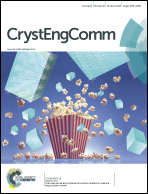Characterization of tetra-n-butylphosphonium bromide semiclathrate hydrate by crystal structure analysis†
Abstract
We report the crystal structure analysis of the semiclathrate hydrate of tetra-n-butylphosphonium bromide (TBPB), which is a candidate material for refrigeration and gas-capture technologies. Refinement of the single crystal X-ray diffraction measurements revealed that the found structure of the TBPB hydrate has an orthorhombic structure, with the space group Pmma, and unit cell parameters a = 21.065(5), b = 12.657(3) and c = 11.992(3) Å. The chemical formula is TBPB·38H2O. The TBP ion is accommodated in a combined cage that consists of two tetrakaidecahedra and two pentakaidecahedra. The structure features three dodecahedral cages for each TBPB molecule that may accommodate small gas molecules (e.g., CH4, CO2 and N2). The structure determined in this work is compared in detail with that of a similar hydrate, tetra-n-butylammonium bromide (TBAB) hydrate. In contrast to the TBAB hydrates, the most stable structure of the TBPB hydrate is not tetragonal but orthorhombic. Since C–P has a longer bond length than C–N, the TBP ion was packed tightly by the combined cage, having complex disorder. The relative comparison of the atom positions showed that the difference in the bond lengths of the two cations is counteracted by the displacement of water molecules in the TBPB hydrate lattice.


 Please wait while we load your content...
Please wait while we load your content...